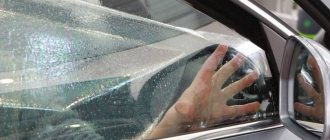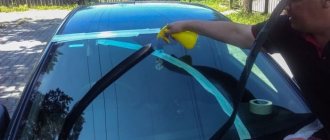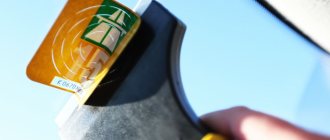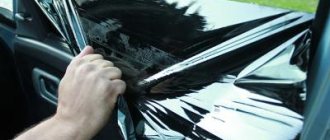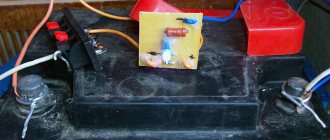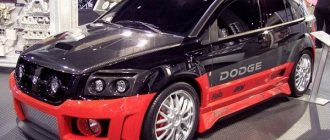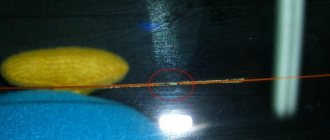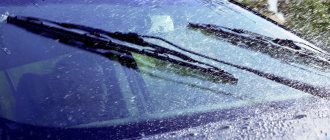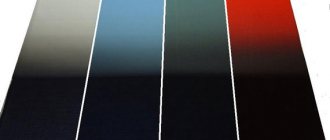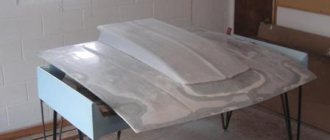Keeping your car's windshield clean is a very important component of accident-free driving. Even not very dirty glass glares much more and prevents the driver from adequately assessing the situation on the road. In the same case, if the trip is made in bad weather conditions, and even on not very good roads, moments often arise when the glass becomes almost “blind” from the dirt flying from under the wheels of the car in front. It is at times like this that it is very important that your windshield wipers work well, and for this it is important to use high-quality windshield cleaning fluid. In the summer, all motorists use plain or distilled water with the addition of various detergent additives, but with the onset of frost they are faced with the question of which “anti-freeze” is best to choose. Unfortunately, high-quality non-freezing liquid does not cost much, and all experts unanimously say that there are too many fakes on the market. Not only can such a low-quality liquid freeze at any time, it also quite often contains a number of additives that cause irreparable harm to the health of the driver and his passengers. Considering all these negative aspects, some motorists prefer to prepare antifreeze washer fluid themselves. Let's look together at ways to prepare glass washing solutions suitable for different weather conditions.
Options for creating windshield wiper fluid.
Water instead of special liquid
In the summer and until frost, motorists can use plain water as a windshield washer without any problems. Some car owners prefer to fill the tank with distilled water, which avoids the formation of salt deposits on the glass and inside the mechanism that supplies liquid to the windshield. Considering the fact that dirt flying from under the wheels of the vehicle in front can be washed off very poorly, drivers are constantly experimenting with adding various additives to increase the cleaning effect of the composition and preparing summer windshield washer with their own hands. Since the onset of sub-zero temperatures, the tactics for preparing washer fluid have changed. Such mixtures will necessarily have to contain ingredients that prevent water from freezing - alcohol, acids, etc.
How to clean the system and prepare it for filling with washer fluid
However, not all motorists are ready to believe such a statement. And therefore, it is still worth giving examples of the simplest washes and their recipes - ones that the reader can easily reproduce at home.
If you have already filled the water, but you are tormented by doubts whether it was the right choice, you can simply pour a not too concentrated solution of citric acid into the tank. To do this, take half a teaspoon of regular food-grade lemon from the store, or even a couple of tablespoons of natural lemon juice. Next, you need to pour the mixture into the tank before washing the car and gradually lower it onto the glass, washing the pump and all elements of the system. Next, do not forget to remove all this liquid from the body and glass.
If you are interested in purified water, which is similar in properties to distilled water, it is also not difficult to obtain. So, it can be collected at self-service car washes as water that does not leave streaks. It can be used either on its own or as a base for more complex liquids, recipes for which will be presented below.
Method No. 1 - using a regular windshield wiper
Very good results can be obtained by mixing any household glass cleaner, which can be purchased in the household appliances department. These products are designed to clean any glass surfaces. It is important to check that these products contain alcohol; it is this that will prevent the liquid in the washer reservoir from freezing. In order to save money and to avoid excessive foaming of the composition, the glass cleaner should be mixed with ordinary or distilled water. It is recommended to mix in a ratio of 1 to 2, that is, take one part of the glass cleaning liquid and add two parts of water to it.
Method number 3 - using dishwashing detergents
This method involves adding dishwashing detergent to the water. Since any product that housewives use to wash dishes foams very much, it needs to be added in small quantities. This is about one tablespoon of quality dishwashing detergent per three liters of water. This method must be treated with some caution - it can only be used in the warm season, but even in mild frosts, it will freeze. To avoid possible complications, it is best to follow the advice of experienced motorists and expose the solution you prepared yourself to the cold. If the solution is not frozen, everything is fine and you can safely pour it into the tank, but if the liquid has signs of crystallization, then this clearly indicates the need to add any alcohol-containing liquid to the solution.
Alcohol is rightfully considered an ideal addition.
Conventional anti-freeze formulations
Any factory anti-freeze for a windshield wiper is based on the same water. However, in cold weather, water freezes and can rupture the tank, water lines and nozzles. Therefore, impurities (alcohols) are added to the water, which increase the frost resistance of the liquid and have effective cleansing properties.
Most modern antifreeze liquids are created based on a mixture of water and one of three alcohols:
- Methyl is the cheapest anti-freeze product, which is almost never produced (only counterfeit) due to the toxicity of methyl fumes to humans and the integrity of the elements and systems of the car. Usually has no odor.
- Isopropyl is the most popular, safe and inexpensive mixture with a slight fragrance odor.
- Ethyl is an expensive ethyl-based liquid with a characteristic “vodka” smell.
In addition, the factory antifreeze may contain detergents. The most important characteristics of the liquid are the freezing point, kinematic viscosity (thickening conditions) and the coefficient of surface tension of the protective film on the glass created by the mixture.
Therefore, buy antifreeze only from well-known brands from trusted sellers, and when purchasing, always carefully read the labels and product data sheet! And if you want to save money, make your own antifreeze liquid for windshield wipers - it’s easy and inexpensive.
Method number 4 - using medical alcohol
As noted earlier, the method when alcohol is added to water is the most effective. This solution can be made in the following proportion:
- 3 – 3.5 liters of water.
- 750 gr. (3 glasses), 70% alcohol or 650 grams - 96%.
Add a tablespoon of any washing powder to the resulting solution and mix it well. This additive is necessary to improve the cleaning properties of the liquid, because dirt containing various oily substances flies onto the windshield.
Method number 5 - add ammonia
Sometimes motorists prefer to make a solution by adding ammonia to it. Here you should adhere to a ratio of 1:3 (one part ammonia to 3 parts water). When preparing the mixture, try to prevent the formation of foam. The main disadvantage of this solution is that it is strictly not recommended to use it if the temperature drops significantly; it will quickly freeze. To prevent this from happening, you can try adding about one hundred grams of vinegar to the composition.
Method No. 7 - add methanol
Methanol is also a non-freezing alcohol, but it is an extremely harmful substance for humans. When deciding to prepare such a mixture, you need to be extremely careful and avoid getting it on the skin or in the respiratory tract. This toxic liquid should be mixed with water as follows: 900 ml. add no more than 100 ml of water. methanol.
Making your own windshield washer fluids can save you some money in the long run, but it requires some knowledge and care on the part of the car owner. Thus, only you can decide what is better: buy a ready-made solution or prepare it yourself.
The main components of a purchased antifreeze washer
The main components of the factory antifreeze:
- Water . To protect against clogging and the appearance of salt deposits, only distilled or demineralized water is used in the washer system. Water serves to dissolve alcohol and wash away contaminants. The content directly depends on the proportion of alcohol in the composition and ranges from 20 to 75%.
- Alcohol. It is a solvent and serves to reduce the freezing point of water to the stated level (from -5 to -30°C) depending on the content - 25 - 75%. The following types of alcohols are used in antifreeze:
- ethanol . It is also the main component of alcoholic beverages. Non-poisonous, non-toxic. It freezes and forms a solid at a temperature of -114.5°C. Does not have a negative effect on plastic parts. Effectively cleanses dirt, leaves no streaks, and quickly evaporates from the surface. The ethanol-based product has a persistent odor of alcohol, which penetrates into the vehicle interior when the heating or ventilation system is operating.
- Isopropyl alcohol . This is an industrial substitute for ethyl alcohol - a product of a chemical reaction of hydrogen and acetone. It is poisonous if ingested, but when used as a part of windshield washer it is not toxic and does not accumulate in the human body. May cause allergic reactions. Isopropanol vapors have a pungent odor that is not completely masked by flavorings. Characterized by a high evaporation rate. It is the basis for mass production of the cleaner due to its low freezing point: an alcohol concentration of 50% guarantees the quality of the product at temperatures down to -35°C.
- Methyl alcohol. This is a highly poisonous liquid with the taste and slight odor of ethyl alcohol. It is characterized by high cleaning properties and a freezing point of -97°C. The toxic effect from inhalation of vapors or contact of methanol on human skin develops over several hours and in some cases may be asymptomatic, but permanent damage to the nervous system leads to a significant and irreversible deterioration in health. Methanol is prohibited for the production of windshield washer fluid by Decree of the Chief State Sanitary Doctor No. 47 of July 11, 2007 “On stopping the use of methyl alcohol in vehicle care products.” In addition, counterfeit products based on methyl alcohol can have an aggressive effect on the rubber parts of the wiper blades and have a low cost - from 100 rubles. for a five-liter bottle.
- Surfactants (surfactants) are compounds that contribute to the destruction of contaminants as a result of chemical reactions. The main component of any detergent. Thanks to such substances, traces of soot and grease stains are removed from the surface. In addition, due to the surfactant, the liquid does not leave streaks on the glass and does not cause clouding of headlights or plastic parts. The high efficiency of the substances makes it possible to reduce their presence in the composition to 1%.
- Stabilizers . They increase the shelf life of anti-freeze products and prevent sedimentation. Propylene glycol used in the composition of the liquid maintains its quality for 2–3 years and does not have a negative effect on the human body. To reduce the cost of the cleaner, ethylene glycol, the vapors of which are toxic, can be used. The content in the composition is no more than 5%.
- Flavors . Used to reduce the odor of alcohol or acetone. They have pronounced floral, fruity or citrus notes. Presence in the composition is from 0.01 to 1% depending on the concentration of the initial solution.
- Dye . It is used to give the solution a blue tint and serves as an indicator of frost resistance: the darker the liquid, the lower its freezing point. Excess dye leads to precipitation, so its share in the composition is no more than 1%.
- Corrosion inhibitor. A substance that slows down or completely stops the oxidation of a metal under the influence of liquids. It is added to the cleaner in a volume of 0.001-0.01% of the total composition.
Signs of high-quality anti-freeze:
- transparent plastic canister with a hard lid;
- membrane on the neck;
- a label containing information about the composition and percentage of substances, as well as about the manufacturer with the address;
- the liquid is clear, without sediment;
- when shaken, a dense, stable foam is formed;
- a product based on ethyl alcohol does not have an unpleasant odor, but has a high cost (more than 500 rubles);
- a product based on isopropyl alcohol has a pronounced odor of acetone, and its intensity directly depends on the freezing temperature: the lower it is, the stronger the odor.
The starting price of a high-quality anti-freeze is 300 rubles. for 5 liters of finished product or 180 rubles. for 1 liter of concentrate.
